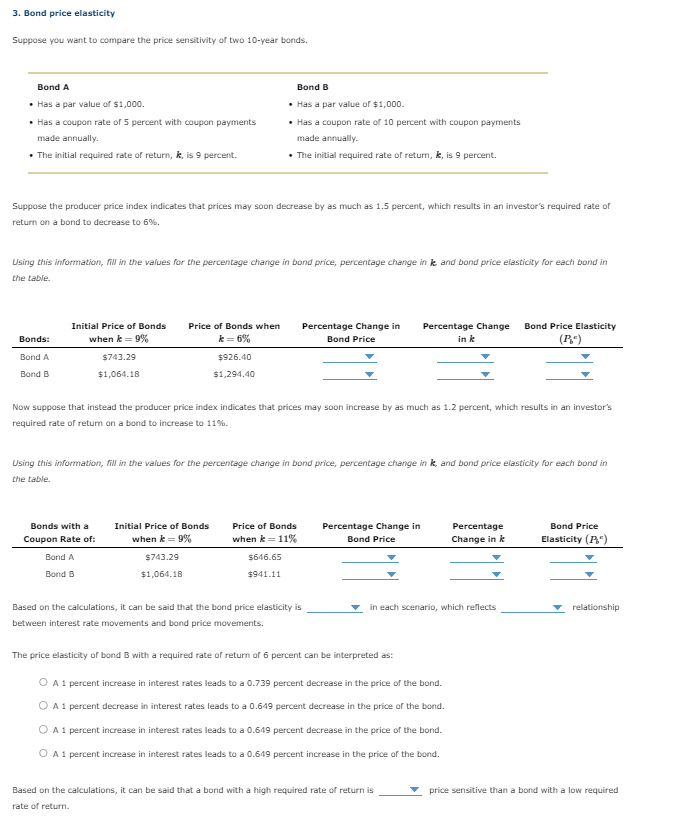
3. Bond price elasticity Suppose you want to compare the price sensitivity of two 10-year bonds. Suppose the producer price index indicates that prices may soon decrease by as much as 1.5 percent, which results in an investor's required rate of return on a bond to decrease to 6%. Using this information, fiw in the values for the percentage change in bond price, percentage change in k and bond price elasticity for each bond in the table Now suppose that instead the producer price index indicates that prices may soon increase by as much as 1.2 percent, which results in an investor's required rate of return on a bond to increase to 11%. Using this information, fiw in the values for the percentage change in bond price, percentage change in k, and bond price elasticity for each bond in the table. Based on the calculations, it can be said that the bond price elasticity is in each scenario, which reflects relationship between interest rate movements and bond price movements. The price elasticity of bond B with a required rate of return of 6 percent can be interpreted as: A 1 percent increase in interest rates leads to a 0.739 percent decrease in the price of the bond. A 1 percent decrease in interest rates leads to a 0.649 percent decrease in the price of the bond. A 1 percent increase in interest rates leads to a 0.649 percent decrease in the price of the bond. A 1 percent increase in interest rates leads to a 0.649 percent increase in the price of the bond. Based on the calculations, it can be said that a bond with a high required rate of return is price sensitive than a bond with a low required rate of return. 3. Bond price elasticity Suppose you want to compare the price sensitivity of two 10-year bonds. Suppose the producer price index indicates that prices may soon decrease by as much as 1.5 percent, which results in an investor's required rate of return on a bond to decrease to 6%. Using this information, fiw in the values for the percentage change in bond price, percentage change in k and bond price elasticity for each bond in the table Now suppose that instead the producer price index indicates that prices may soon increase by as much as 1.2 percent, which results in an investor's required rate of return on a bond to increase to 11%. Using this information, fiw in the values for the percentage change in bond price, percentage change in k, and bond price elasticity for each bond in the table. Based on the calculations, it can be said that the bond price elasticity is in each scenario, which reflects relationship between interest rate movements and bond price movements. The price elasticity of bond B with a required rate of return of 6 percent can be interpreted as: A 1 percent increase in interest rates leads to a 0.739 percent decrease in the price of the bond. A 1 percent decrease in interest rates leads to a 0.649 percent decrease in the price of the bond. A 1 percent increase in interest rates leads to a 0.649 percent decrease in the price of the bond. A 1 percent increase in interest rates leads to a 0.649 percent increase in the price of the bond. Based on the calculations, it can be said that a bond with a high required rate of return is price sensitive than a bond with a low required rate of return







